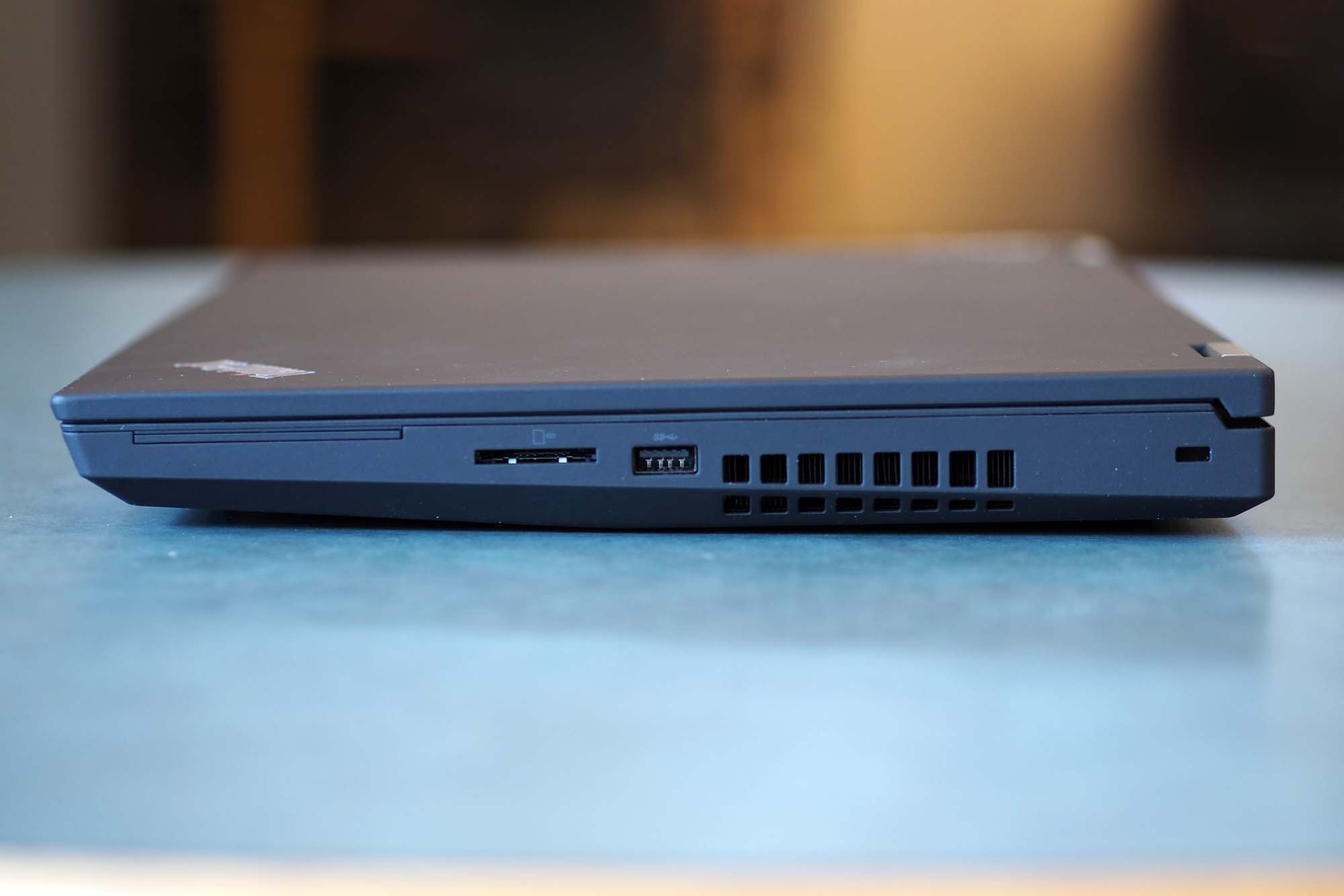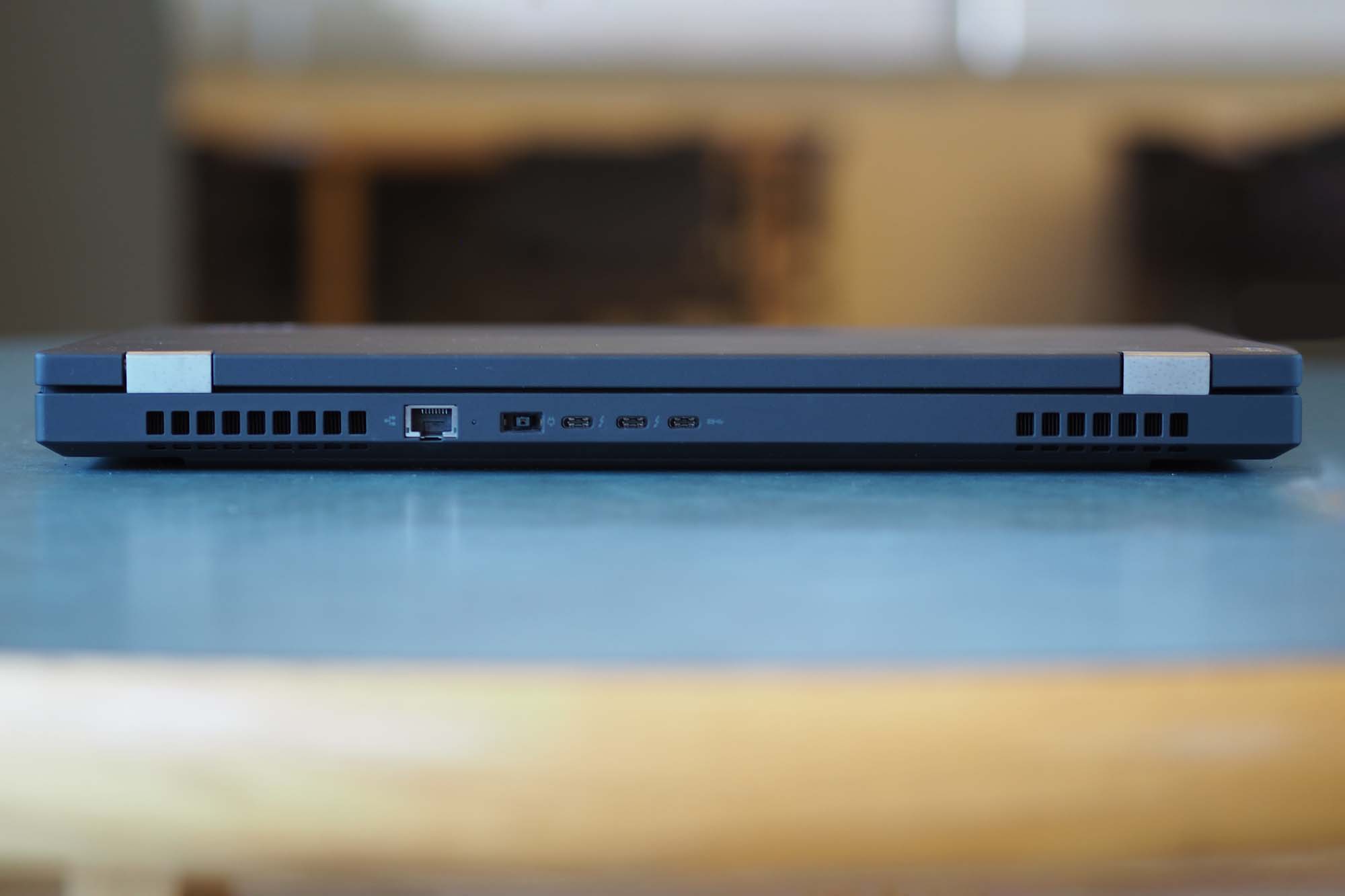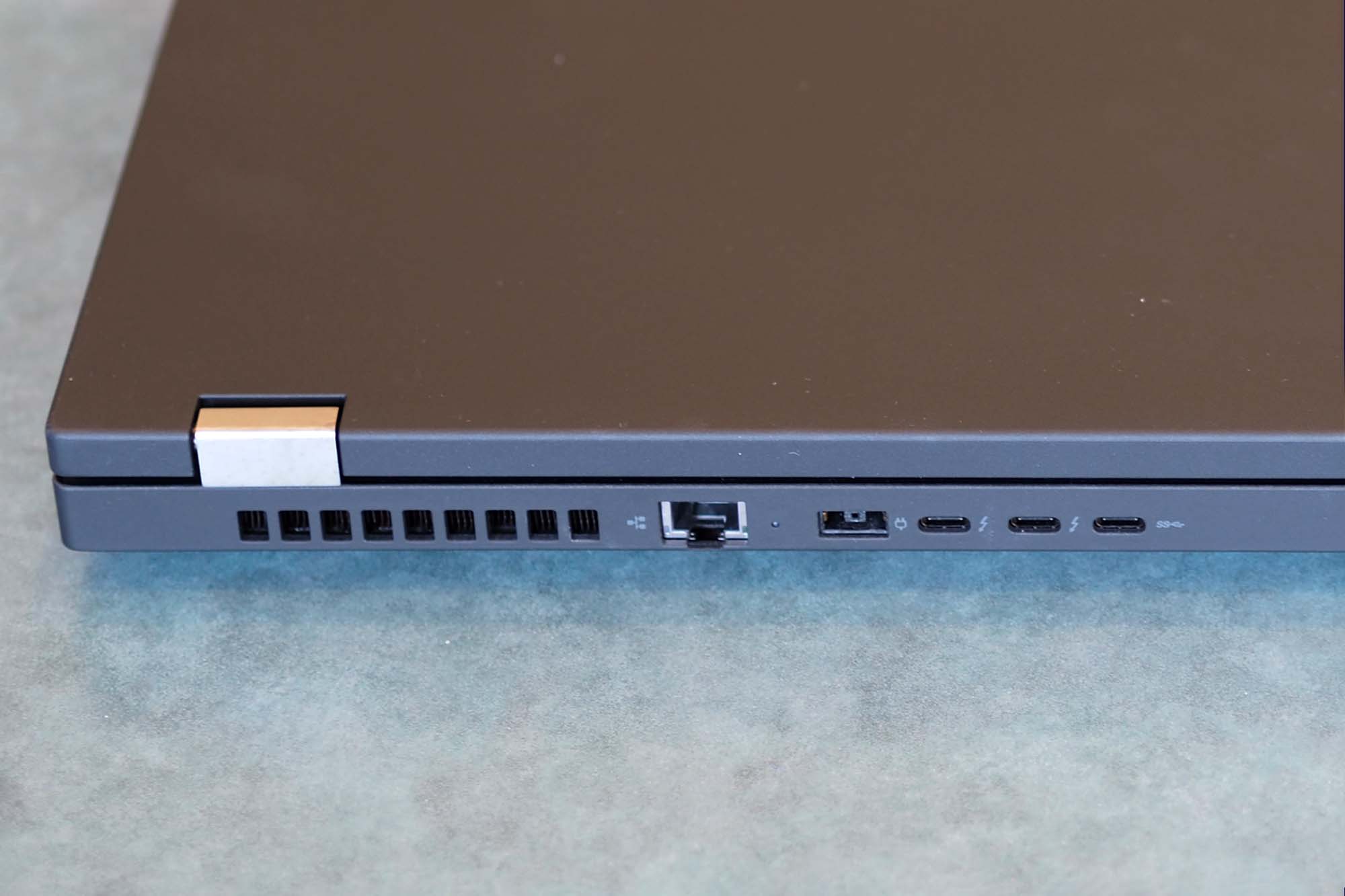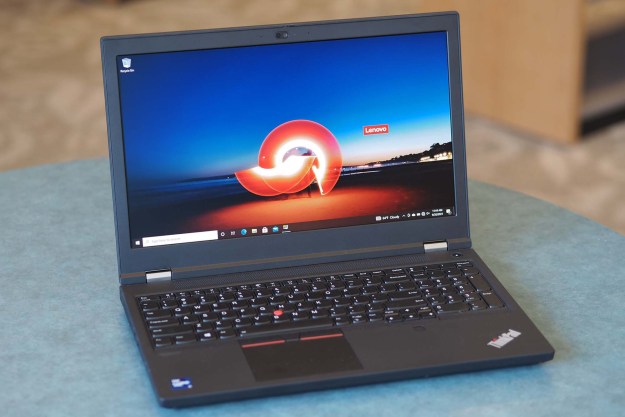
“The Lenovo ThinkPad P15 is a dying breed, but remains relevant for its expandability.”
- Durable build quality
- Quality entry-level display
- Great keyboard
- Superior expandability
- Solid performance
- Not that much faster than less expensive laptops
- Touchpad is too small
- Expensive
We don’t usually review mobile workstations, but a significant trend has developed around laptops aimed at creators. These thin-and-light laptops, like the Dell XPS 15, are surprisingly good at accelerating demanding tasks like video editing. They also boast brilliant, color-accurate OLED displays.
So, when Lenovo offered us the ThinkPad P15 Gen 2 for review with a Core i9-11950H CPU and an Nvidia Quadro RTX A5000 GPU, we jumped at the opportunity to see how a more traditional approach to a mobile workstation would stack up.
Is the ThinkPad P15 proof that old-school workstations are a thing of the past? In some ways, yes. But because of its unique features, the audience for this expensive laptop remains very limited.
Design
The ThinkPad P15 looks exactly like a ThinkPad should — only it’s incredibly thick and heavy. There’s the usual black aesthetic with just a few hints of red, including the iconic LED “i” in the ThinkPad logo on the lid. There’s also the same soft-touch surface and the usual red TrackPoint nubbin in the center of the keyboard.
The most prominent difference in look and feel from the typical ThinkPad is in the extra venting along the sides and back, which hints at the ThinkPad P15 being different. Oh, that, and the massive bezels around the display that look like the ones you’d find on a laptop from 10 years ago.

Then there’s that size. Where modern ThinkPads, at least the more premium consumer and business models, are thin and light, the ThinkPad P15 is just huge. It’s 0.96 inches at its thinnest point and 1.24 inches at its thickest, and it weighs 6.32 pounds. I thought the ThinkPad X1 Extreme Gen 4 was a little larger than it should be, but the ThinkPad P15 dwarfs its 0.70-inch thickness and 3.99 pounds. It’s a little comical to set the two side by side — they’re almost identical in width and depth, and they have similar appearances, but the ThinkPad P15 looks like a balloon version that someone pumped up with extra air.
Not that there’s anything wrong with any of this. The ThinkPad P15 is a workstation-class laptop and doesn’t pretend to be a highly portable, relatively fast laptop like the ThinkPad X1 Extreme or the Dell XPS 15. Instead, it’s meant to offer plenty of room inside to move air around and keep things cool and fast, along with providing extra expandability. In fact, that expandability is what sets this laptop apart the most.
You can configure up to 128GB of RAM via four SO-DIMM slots (and you can select error-correcting

In terms of its durability, the ThinkPad P15 is close to the usual ThinkPad standards. An internal magnesium frame holds the bottom chassis together, with a plastic and glass-fiber material covering it to provide extra protection and that soft touch. The keyboard deck and bottom chassis feel quite sturdy. The lid is made of plastic and glass fiber, and it’s a bit more flexible than I like to see. The ThinkPad P15 isn’t quite up to the standards of the ThinkPad X1 Extreme Gen 4 or the XPS 15, but it feels durable enough. Of course, it passed through Lenovo’s usual MIL-STD 810G testing, which provides some extra confidence.
Connectivity is a strength, as you’d imagine with this class of machines (and given all the room to fit connections). On the left-hand side is a full-size
Finally, in the back is an Ethernet port, a connection for the 230-watt power adapter, two USB-C ports with Thunderbolt 4 support, and a USB-C 3.2 Gen 2 port. Wi-Fi 6E and Bluetooth 5.2 provide wireless connectivity.
Performance
This isn’t a cheap laptop. As configured at retailer CDW, the ThinkPad P15 I reviewed costs a whopping $5,445 — scary when you consider my review unit has “only” 32GB of
With all that upgradability, the ThinkPad P15 promises incredible performance for demanding creative tasks. We’ve reviewed several
The ThinkPad P15 is fast, but it’s not as dominant as you might expect. It did very well in Geekbench 5, earning the highest score for a laptop in our review database. But it’s not as far ahead of the pack as I expected, with the Asus Vivobook Pro 16X OLED coming in reasonably close behind thanks to its AMD Ryzen 9 5900HX CPU, especially in the multi-core portion of the test. Even the Dell XPS 17 with its Core i7-11800H was in the same ballpark (surprisingly faster than the Vivobook Pro 16X).
In our Handbrake test that encodes a 420MB video as H.265, the ThinkPad P15 was again the fastest laptop we’ve tested — and again the Vivobook Pro 16X was almost as fast. In fact, the ThinkPad P15 wasn’t that much quicker than the other
The ThinkPad P15 doesn’t perform well enough to merit its incredibly high price.
You probably won’t be surprised to hear that the ThinkPad P15 was once again the fastest in another test, PCMark 10, and that another thin-and-light laptop was close — this time, the MSI Creator Z16. That held across the Essentials, Productivity, and even the Content Creation portion of the test, where the ThinkPad P15 was again fast, but not so much faster.
I thought that certainly PugetBench, which runs in Premiere Pro, would let the ThinkPad P15 shine. After all, the laptop has Independent Software Vendor (ISV) certifications from several developers, including Adobe. ISV certification means that the hardware and software are developed to work together for the best performance and reliability. However, the ThinkPad P15 scored 724, less than the MSI Creator Z16’s 738 and not much faster than the Dell XPS 17’s 692. Once again, the ThinkPad P15 hadn’t shown any real advantage over
I’m not sure it’s a knock against the ThinkPad P15 or a testament to just how powerful thinner and lighter
| Geekbench 5 (single/multi) |
Cinebench R23 (single/multi) | Handbrake (seconds) | PCMark 10 | Pugetbench Premiere Pro | 3DMark Time Spy | |
| Lenovo ThinkPad P15 (Core i9-11950H) | 1691 / 9250 | 1596 / 12207 | 84 | 6866 | 724 | 9045 |
| MSI Creator Z16 (Core i7-11800H) | 1540 / 7625 | 1444/9615 | 102 | 6486 | 738 | 6322 |
| Lenovo ThinkPad X1 Extreme Gen 4 (Core i7-11800H) | 1520 / 7353 | 1519/10497 | 106 | 6251 | 432 | 6691 |
| Dell XPS 15 (Core i7-11800H) | 1556 / 7692 | 1513/9979 | 103 | 6024 | 509 | 4540 |
| Dell XPS 17 (Core i7-11800H) | 1568 / 8801 | 1525/10145 | 109 | 6209 | 692 | 7039 |
| Asus Vivobook Pro 16X (Ryzen 9 5900HX) | 1544 / 8299 | 1486/11478 | 90 | 6486 | 571 | 4601 |
You don’t buy a workstation-class laptop to play games, but that doesn’t mean you won’t game on occasion. So, I ran the ThinkPad P15 through a few of our benchmark titles to see how it would perform with the Nvidia Quadro RTX A5000. That’s not a gaming GPU, but it’s still pretty powerful and should be able to run modern titles at decent resolutions and frame rates. According to 3DMark Time Spy, it’s about as fast as a GeForce RTX 3070.
It may not be meant as a gaming laptop, but it acts like one.
The ThinkPad P15 performed well in Assassin’s Creed Valhalla, hitting 76 frames per second (fps) at 1080p and high graphics and 67 fps at ultra high graphics. The Lenovo Legion 5 Pro
I also ran Civilization VI and saw 218 fps at 1080p and medium graphics and 155 fps at ultra graphics. The next fastest laptop in our database is the Lenovo Legion 5 Pro with a Ryzen 7 5800H and an RTX 3070, which hit 127 fps and 114 fps, respectively. Clearly, the ThinkPad P15 excels at this game that’s both CPU- and GPU-intense.
So, yes, you can game with the ThinkPad P15 and play modern titles at high graphics. It may not be meant as a
Display
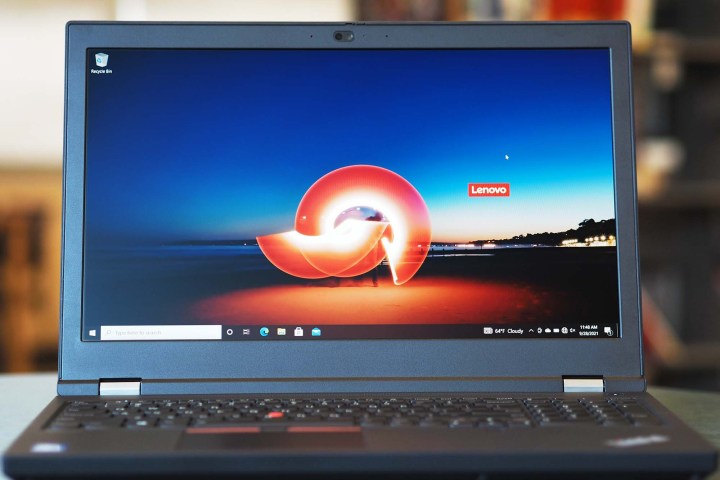
You can configure the ThinkPad P15 with several displays, all 15.6-inches in the old-school 16:9 aspect ratio. There are Full HD (1,920 x 1,080) anti-glare, Full HD with
According to my colorimeter, this is a good but not great premium display, and it’s not aimed at creative types. Brightness was excellent at 542 nits (we like to see 300 nits or better), and the contrast ratio topped our 1,000:1 threshold at 1,040:1. Colors were close to the premium display average at 76% of AdobeRGB and 100% of sRGB, with color accuracy of DeltaE 1.49 (less than 1.0 is considered excellent). Those are all fine results, in line with what you’ll get from
Again, I have to say: This is a fine display, but not for the price. Yes, it’s great for productivity work, but if you’re spending over $5,000 on a laptop that’s intended at least in part for creative work, then you’ll want wider and more accurate colors. You’ll want to opt for the OLED panel, which is likely to rival the other OLED panels we’ve tested that have provided superior colors and contrast across the board. Given Lenovo’s pricing right now, you could probably find a model with the OLED panel for less than what you’ll currently spend on my review unit.
The audio was weak, with low volume even when turned all the way up. Mids and highs were clear enough, and there was zero bass. There’s not much to say here — sound quality clearly wasn’t a priority with the ThinkPad P15, and you’ll want
Keyboard and touchpad

Just like all ThinkPads, the ThinkPad P15 sports the same keyboard with superior travel (1.8mm), a snappy mechanism and a spacious layout with large, sculpted keys. Interestingly, I found the keyboard on the ThinkPad P15 to be lighter than the one on the ThinkPad X1 Extreme Gen 4, which I liked. The ThinkPad P15 required less force to depress the keys, reducing fatigue and keeping me up to my usual speed of around 90 words a minute. I’d rate this keyboard as close to my favorite, the one on the HP Spectre line, which is something I couldn’t say about the ThinkPad X1 Extreme Gen 4.
The touchpad is small given the laptop’s overall size, and it loses space to the TrackPoint buttons. It works fine, supporting Microsoft’s Precision Touchpad drivers (pretty much a given over the last couple of years) — it’s just too small. TrackPoint is there if you want it, and it works as well as usual. It’s standard for ThinkPads, but I do wonder sometimes how many people actually use it. Note that if you opt for an OLED display, then you get a touch panel and active pen support.
Windows 10 Hello support is provided by both a fingerprint reader and infrared camera with facial recognition. I tried both methods and they were uniformly quick and accurate. No complaints there. The typical ThinkPad ThinkShutter privacy screen is there to block the webcam when you don’t want anyone spying on you.
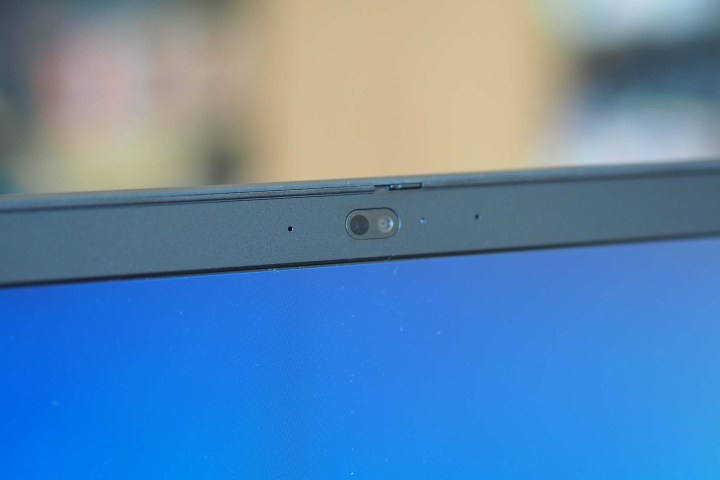
Battery life
If there’s one area where I had low expectations heading into the review, it was battery life. No way did I expect the ThinkPad P15 to display anything approaching all-day longevity, even when running simple productivity tasks. Suffice it to say, I was a little surprised.
There’s 94 watt-hours of battery packed away inside the huge chassis, and that helps. As does the Full HD display. But even so, I was surprised when the ThinkPad P15 lasted 9.5 hours on our web-browsing test. That’s half an hour longer than the Dell XPS 15, and more than two hours longer than the Lenovo ThinkPad X1 Extreme Gen 4. In our video test that loops a local Full HD Avengers trailer, the ThinkPad P15 lasted for about 11.5 hours, not a great score, but better than the XPS 15 by six minutes and the ThinkPad X1 Extreme Gen 4 by more than two hours (again). That’s not bad for a workstation.
Things weren’t quite so good in the PCMark 10 Applications benchmark, which is the best test of productivity longevity. Here, the ThinkPad P15 lasted for just under 6.5 hours, less than the XPS 15’s eight hours and the ThinkPad X1 Extreme Gen 4’s 8.7 hours. And in the PCMark 10 Gaming test that pushes the CPU and GPU, the ThinkPad P15 lasted for just 56 minutes. That’s the lowest score in our database, with the XPS 15 and ThinkPad X1 Extreme Gen 4 both lasting for about a half-hour longer. Clearly, the ThinkPad P15 keeps up the performance while unplugged.
Overall, these are better scores than I anticipated. Certainly, you’ll need to carry around the bulky 230-watt power brick if you’re going to do workstation-level work. But if you have a light day planned of typical productivity tasks, you’ll probably make it through most of the day. That’s not bad for a workstation.
Our take
In the configuration I reviewed, the ThinkPad P15 feels outdated. It’s isn’t so much faster than the fastest thin-and-light
That’s a special kind of person, and that’s who this workstation is aimed at. We were curious to see how it would stack up against the typical
Are there any alternatives?
If you need to match the ThinkPad P15’s high-end specs, then you’ll need to look at other workstation-class
MSI’s WS65 Mobile Workstation also comes close. It, too, supports Quadro RTX A5000 graphics, but only up to 64GB of
If you don’t really need a workstation, then your choices are much broader. The Dell XPS 15 provides enough power for all but the most demanding creators, it’s relatively thin and light and incredibly well built, and it’s about half the price.
How long will it last?
The ThinkPad P15 is durable enough that it should last for years of carrying it from place to place. It also has modern components and incredible expandability. It’s insane, though, that a laptop costing over $5,000 should come with a one-year warranty.
Should you buy it?
Yes, but only if you need to max it out. This laptop is for extreme power users who likely won’t be satisfied with my review unit’s configuration.
Editors' Recommendations
- Best Lenovo laptop deals: Save on Yoga and ThinkPad laptops
- This tiny ThinkPad can’t quite keep up with the MacBook Air M2
- Why the latest ThinkPad X1 Yoga Gen 8 isn’t worth the upgrade
- Lenovo ThinkPad X1 Fold Gen 2 hands-on review: a sleek redo
- Lenovo teams up with AMD and Nvidia to release two new workstations

